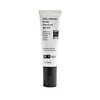What's inside
What's inside
 Key Ingredients
Key Ingredients

 Benefits
Benefits

 Concerns
Concerns

 Ingredients Side-by-side
Ingredients Side-by-side

Octocrylene 4.9%
UV AbsorberEctoin
Skin ConditioningAvena Sativa Bran Extract
AbrasiveBisabolol
MaskingButylene Glycol
HumectantButyloctyl Salicylate
Skin ConditioningCaffeine
Skin ConditioningCaprylyl Methicone
Skin ConditioningCitrus Aurantium Dulcis Peel Extract
Emulsion StabilisingCyclopentasiloxane
EmollientEthyl Ferulate
AntioxidantEthylhexylglycerin
Skin ConditioningHydroxyethyl Acrylate/Sodium Acryloyldimethyl Taurate Copolymer
Emulsion StabilisingOctyldodecyl Neopentanoate
EmollientOleth-3 Phosphate
PEG-7 Trimethylolpropane Coconut Ether
EmulsifyingPhenoxyethanol
PreservativePolyisobutene
Propanediol
SolventSilybum Marianum Seed Extract
Skin ConditioningSodium Hyaluronate
HumectantSodium Stearoyl Glutamate
CleansingTocopheryl Acetate
AntioxidantTriethoxycaprylylsilane
Water
Skin ConditioningOctocrylene 4.9%, Ectoin, Avena Sativa Bran Extract, Bisabolol, Butylene Glycol, Butyloctyl Salicylate, Caffeine, Caprylyl Methicone, Citrus Aurantium Dulcis Peel Extract, Cyclopentasiloxane, Ethyl Ferulate, Ethylhexylglycerin, Hydroxyethyl Acrylate/Sodium Acryloyldimethyl Taurate Copolymer, Octyldodecyl Neopentanoate, Oleth-3 Phosphate, PEG-7 Trimethylolpropane Coconut Ether, Phenoxyethanol, Polyisobutene, Propanediol, Silybum Marianum Seed Extract, Sodium Hyaluronate, Sodium Stearoyl Glutamate, Tocopheryl Acetate, Triethoxycaprylylsilane, Water
Butyl Methoxydibenzoylmethane 3%
UV AbsorberHomosalate 7%
Skin ConditioningOctocrylene 9%
UV AbsorberEthylhexyl Salicylate 5%
UV AbsorberWater
Skin ConditioningGlycerin
HumectantButyloctyl Salicylate
Skin ConditioningC12-15 Alkyl Benzoate
AntimicrobialPongamia Glabra Seed Oil
Skin ConditioningUndecane
EmollientBetaine
HumectantSilica
AbrasiveEthyl Ferulate
AntioxidantOryza Sativa Extract
AbsorbentOryza Sativa Germ Extract
EmollientGlycine Soja Seed Extract
Skin ConditioningTridecane
PerfumingGlycine Soja Oil
EmollientSodium Dilauramidoglutamide Lysine
HumectantDunaliella Salina Extract
Skin ConditioningHaematococcus Pluvialis Extract
AntioxidantInulin
Skin ConditioningFructose
HumectantGlucose
HumectantPongamia Pinnata Seed Extract
Skin ConditioningPolyglyceryl-4 Laurate
EmulsifyingHydroxyethyl Acrylate/Sodium Acryloyldimethyl Taurate Copolymer
Emulsion StabilisingHydroxyacetophenone
AntioxidantArachidyl Alcohol
EmollientPolyglyceryl-6 Laurate
Emulsifying1,2-Hexanediol
Skin ConditioningCaprylyl Glycol
EmollientBehenyl Alcohol
EmollientCellulose Gum
Emulsion StabilisingPolyglyceryl-3 Diisostearate
EmulsifyingArachidyl Glucoside
EmulsifyingTocopherol
AntioxidantSodium Phytate
Polysorbate 60
EmulsifyingSorbitan Isostearate
EmulsifyingCitric Acid
BufferingXanthan Gum
EmulsifyingCellulose
AbsorbentButyl Methoxydibenzoylmethane 3%, Homosalate 7%, Octocrylene 9%, Ethylhexyl Salicylate 5%, Water, Glycerin, Butyloctyl Salicylate, C12-15 Alkyl Benzoate, Pongamia Glabra Seed Oil, Undecane, Betaine, Silica, Ethyl Ferulate, Oryza Sativa Extract, Oryza Sativa Germ Extract, Glycine Soja Seed Extract, Tridecane, Glycine Soja Oil, Sodium Dilauramidoglutamide Lysine, Dunaliella Salina Extract, Haematococcus Pluvialis Extract, Inulin, Fructose, Glucose, Pongamia Pinnata Seed Extract, Polyglyceryl-4 Laurate, Hydroxyethyl Acrylate/Sodium Acryloyldimethyl Taurate Copolymer, Hydroxyacetophenone, Arachidyl Alcohol, Polyglyceryl-6 Laurate, 1,2-Hexanediol, Caprylyl Glycol, Behenyl Alcohol, Cellulose Gum, Polyglyceryl-3 Diisostearate, Arachidyl Glucoside, Tocopherol, Sodium Phytate, Polysorbate 60, Sorbitan Isostearate, Citric Acid, Xanthan Gum, Cellulose
 Reviews
Reviews

Ingredients Explained
These ingredients are found in both products.
Ingredients higher up in an ingredient list are typically present in a larger amount.
Butyloctyl Salicylate is a chemical UV filter structurally similar to octisalate. It is a photostabilizer, SPF booster, emollient and solvent. This ingredient helps evenly spread out ingredients.
According to a manufacturer, it is suitable for pairing with micro Titanium Dioxide, Zinc Oxide, and pigments.
Photostabilizers help stabilize UV-filters and prevents them from degrading quickly.
Learn more about Butyloctyl SalicylateEthyl ferulate is an antioxidant derived from ferulic acid and ethyl alcohol. You'll most likely see this ingredient in sunscreens.
One study from 2014 found a concentration of 10% showed a similar SPF to Benzimidazole. Though this is considered a chemical UV filter, this ingredient is not listed as so. This is due to regulatory loopholes. You'll likely find this ingredient in "100% mineral" sunscreens.
This ingredient is typically found in concentrations between 0.5-1%. It is usually created synthetically or from rice bran oil.
Learn more about Ethyl FerulateThis is a synthetic polymer. It helps improve the texture of products by adding thickness and gel-like feel.
It is also an emulsifer, meaning it prevents ingredients such as oil and water from separating. It also helps evenly disperse other ingredients.
Octocrylene protects skin from sun damage. It absorbs UV-B with peak absorption of 304 nm. It is a common sunscreen ingredient and often paired with avobenzone, a UVA filter. This is because octocrylene stabilizes other sunscreen ingredients by protecting them from degradation when exposed to sunlight. Octocrylene is a photostable ingredient and loses about 10% of SPF in 95 minutes.
Octocrylene also acts as an emollient, meaning it helps skin retain moisture and softens skin. It is oil-soluble and hydrophobic, enhancing water-resistant properties in a product.
Those who are using ketoprofen, a topical anti-inflammatory drug, may experience an allergic reaction when using octocrylene. It is best to speak with a healthcare professional about using sunscreens with octocrylene.
The EU allows a maximum of these concentrations:
Learn more about OctocryleneWater. It's the most common cosmetic ingredient of all. You'll usually see it at the top of ingredient lists, meaning that it makes up the largest part of the product.
So why is it so popular? Water most often acts as a solvent - this means that it helps dissolve other ingredients into the formulation.
You'll also recognize water as that liquid we all need to stay alive. If you see this, drink a glass of water. Stay hydrated!
Learn more about Water